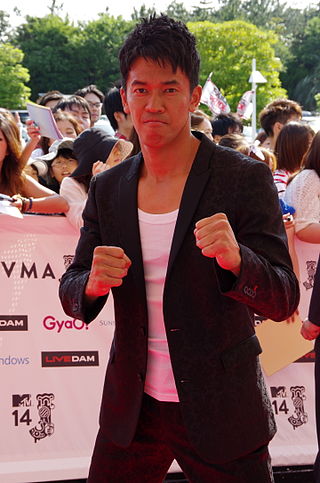
Saishū Onoe was the pen name of Hachirō Onoe, a Japanese tanka poet, educator, and calligrapher.
Kyōiku kanji, also known as Gakunenbetsu kanji haitōhyō is a list of 1,026 kanji and associated readings developed and maintained by the Japanese Ministry of Education that prescribes which kanji, and which readings of kanji, Japanese students should learn from first grade to the sixth grade. Although the list is designed for Japanese students, it can also be used as a sequence of learning characters by non-native speakers as a means of focusing on the most commonly used kanji.

Ekiden (駅伝) is a long-distance running multi-stage relay race, mostly held on roads.

The Japan Association of Athletics Federations is the national governing body for the sport of athletics in Japan.
Hakone Ekiden (箱根駅伝), officially called the Tokyo-Hakone Round-Trip College Ekiden Race, is one of the most prominent university ekiden races of the year held between Tokyo and Hakone in Japan on January 2 and 3. The race is telecast on Nippon Television.
Yoshimasa Hosoya is a Japanese voice actor and narrator.

Soyu Stadium, formerly known as Akita Yabase Athletic Field, is an athletic stadium in Akita, Akita, Japan. Located approximately 3 kilometers from the city center, the Akita Yabase Stadium is a multi-use facility opened in September 1941. It has been renovated several times, including a complete rebuilding in 1981, track repairs in 1985, and modifications in 1995 to accommodate the requirements for J.League soccer.
The corporate ekiden competition is a series of races contested between Japan's corporate (business) running teams. The championships are officially the 全日本実業団対抗駅伝競走大会),The structure involves regional qualifying races and a national championship for women and for men.

The Japan Championships in Athletics is an annual outdoor track and field competition, organized by Japan Association of Athletics Federations. Currently it takes place in June or July. The competition is also for the qualifying trial for the Japanese national team of international competitions.

The Shanghai Japanese School (SJS) is a Japanese international school serving primary and junior high school levels in Shanghai. It has two campuses, one in Hongqiao and one in Pudong. The school's teachers are Japanese citizens. The school also has a senior high school component.
"Moonlight Densetsu" is a song that served as an opening theme for the anime series, Sailor Moon.
Tadahiko Mibuchi was the first Chief Justice of Japan (1947–1950).

Izuo Anno was a Japanese Olympic athlete who participated in the 1932 Summer Olympics in Los Angeles. He was born in Yamaguchi Prefecture. He competed in the 100m and 200m sprints. He was 169 cm tall and weighed 63 kg. He was a graduate of Keio University. During the Second Sino-Japanese War, while undergoing his military service, he was killed in action in Nanning, Guangxi, Republic of China.
Direct Opposing Rook is an Opposing Rook opening in which the player's bishop diagonal remains open allowing for a bishop trade early in the opening.

Takemi Miyamae is a Japanese conditioning coach for the Chunichi Dragons in Japan's Nippon Professional Baseball.

Sō Takei is a Japanese tarento and former track and field athlete. He was an established athlete with multiple championships for athletics and decathlon. Takei is currently active as a tarento, frequently appearing on television. He calls himself the King of Beasts, a nickname that has become associated with Takei for his persona in the entertainment industry.

The China–Japan–Korea Friendship Athletic Meeting is an annual international outdoor track and field competition between the East Asian countries of China, Japan and South Korea. Jointly organised by the Chinese Athletic Association, Japan Association of Athletics Federations and Korea Association of Athletics Federations, it was first held in 2014 and host responsibilities rotate between the three nations.

Alpas is a group of sports facilities in Kazuno, Akita, Japan. Full-scale alpine, jumping ski, cross-country skiing and nordic combined competitions can be held in one place.












